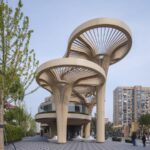Solar Trees Marketplace, located in Shanghai, China, represents a pioneering approach to retail architecture designed by Koichi Takada Architects. Completed in 2023, this 3450 m² space is envisioned as an evolving retail destination and a symbol of the city’s commitment to integrating nature into urban environments.

History and Context
Situated on a site that was densely forested just four decades ago, Solar Trees Marketplace is a response to the rapid urbanization of Shanghai and a step towards reintroducing green spaces to the city. The project reflects Koichi Takada Architects’ dedication to biophilic architecture, emphasizing the importance of sustainability and nature-centric design in contemporary urban development.
Phase I: Adaptive Design for Longevity
Phase I of Solar Trees Marketplace serves as an immersive sales and display suite for an adjacent residential masterplan development. Designed to adapt and evolve over time, this phase showcases the organic tree-like structure as a symbolic gateway to the larger masterplan area, promoting pedestrian activity and connecting residents with nature.

Phase II: A Vibrant Community Hub
As the residential community develops, Solar Trees Marketplace will transition into a vibrant marketplace, echoing the vision of traditional Chinese marketplaces in a modern context. A translucent canopy of photovoltaic cells will power the operation of this community hub, supporting local businesses and fostering a sense of community among residents.
Biophilic Design Principles
Solar Trees Marketplace embodies biophilic design principles, seamlessly blending natural elements with architectural aesthetics. The structure is designed to merge with a promenade of native Camphor trees over time, creating an oasis of calm amidst the urban landscape. Thoughtful manipulation of light and shadow enhances the visual appeal while promoting natural ventilation and reducing the need for artificial lighting.

Architect’s Vision
Koichi Takada emphasizes the importance of design in creating a living environment that inspires and nurtures both residents and the community. By embracing biophilic design principles, Solar Trees Marketplace showcases the potential of sustainable innovation and serves as a catalyst for conversations about the integration of nature into urban architecture.
Conclusion
Solar Trees Marketplace in Shanghai is not only a retail destination but also a testament to the transformative power of architecture. By harmonizing nature and design, this project sets a new standard for sustainable and community-centric urban development, paving the way for a greener and more resilient future.






















